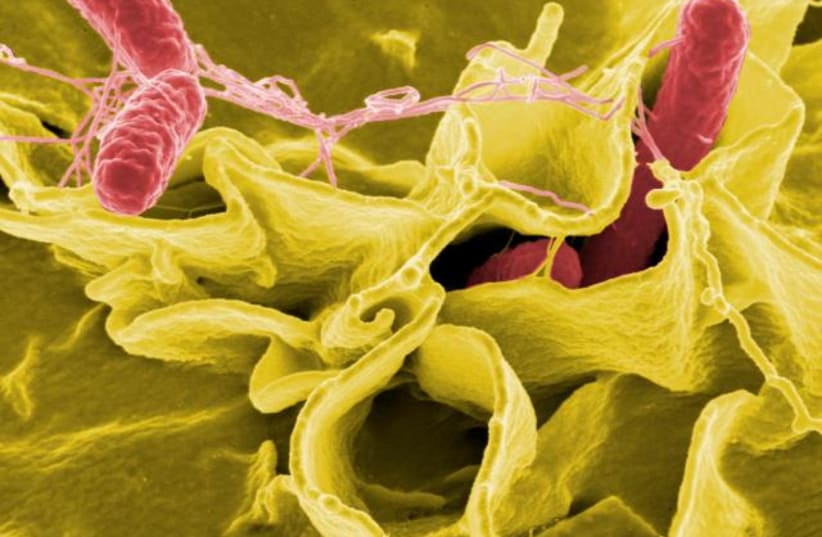Consumers can expect to face empty confectionery shelves in supermarkets across Israel in the coming weeks after Strauss Group recalled a large number of their products due to salmonella contamination in the Elite chocolate production facility.
What is salmonella?
Salmonella are a diverse group of bacteria, with the most common strain causing an illness called salmonellosis, a form of food poisoning, although it can also be contracted through non-food-related means. Some foods have a higher risk for salmonella contamination. These include chicken and pork, and a variety of vegetables such as lettuce, spinach, cabbage, celery and tomatoes.
Symptoms of salmonella usually begin from six hours to six days after ingesting the contaminant and can last between four to seven days. However, some people will experience symptoms for as long as several weeks. In extreme cases, salmonella strains can cause infection in urine, blood, bones, joints or in the nervous system, and result in severe disease.
The symptoms most commonly include nausea, vomiting, abdominal pain, diarrhea, fever and chills.
According to the Health Ministry, children under five, infants who are not breastfed, adults age 65 and older, and people with a weakened immune system are more likely to contract salmonella and experience more severe infections.
How does salmonella spread in a food production facility and can it be prevented?
Because salmonella is a pathogen that is prevalent in the gut of many animals and insects, it can spread by the animal’s feces into the soil, water and food. From there it can easily be introduced into and spread throughout a food production facility by way of raw ingredients, as was the case with the Strauss facility. It can also spread through the facility via contaminated packaging, equipment and workers’ hands and clothing.
Salmonella thrives in moist, warm environments such as drains, floors and processing equipment, making a food production facility the perfect environment for it.
However, there are several ways to ensure that the risk of salmonella contamination in a food facility is lessened, according to international cleaning equipment supplier Vikan’s hygiene and compliance manager Stine Lønnerup Bislev.
The first step to controlling the spread of the bacteria is to ensure that only clean and disinfected equipment, tools and utensils are brought into the processing area, Bislev explains on the company’s website. Then, all incoming ingredients and materials that pose a risk for contamination should be tested for salmonella ahead of production.
Ingredients must be cleaned and disinfected properly, using either a wet or dry cleaning method, depending on the moisture content of the ingredient. High moisture ingredients that require wet cleaning include meat, vegetables and dairy products, Bislev notes.
To avoid the spread of contamination, raw and processed foods must be handled in separate areas, using separate tools and equipment. Cleaning equipment should meet the appropriate hygiene standards to facilitate easy cleaning and prevent microbial growth.
Hygenic design features include smooth surfaces, one-piece construction, easy dismantling and a lack of crevices.
Finally, Bislev states, a program should be developed by the production facility’s management in order to routinely sample the space for salmonella.
“An environmental monitoring program will assess the effectiveness of your overall hygienic practices, monitor the environment for transient pathogens and help mitigate potential harborage and growth niches,” she concludes.
How does salmonella spread in a food production facility and can it be prevented?
Because salmonella is a pathogen that is prevalent in the gut of many animals and insects, it can spread via the animal’s feces into the soil, water and food. From there it can easily be introduced into and spread throughout, a food production facility via raw ingredients, as was the case with Strauss’ facility. It can also spread through the facility via contaminated packaging, equipment, and workers’ hands and clothing.
Salmonella thrives in moist, warm environments such as drains, floors, and processing equipment, making a food production facility the perfect environment for it.
However, there are several ways to ensure that the risk of salmonella contamination in a food facility is lessened, according to international cleaning equipment supplier Vikan’s Hygiene and Compliance Manager Stine Lønnerup Bislev.
The first step to controlling the spread of the bacteria is to ensure that only clean and disinfected equipment, tools and utensils are brought into the processing area, Bislev explains in an explainer on the company’s website. Then, all incoming ingredients and materials that pose a risk for contamination should be tested for salmonella ahead of production.
Ingredients must be cleaned and disinfected properly, using either a wet or dry cleaning method depending on the moisture content of the ingredient. High moisture ingredients that require wet cleaning include meat, vegetables and dairy products, she explains.
To avoid the spread of contamination, raw and processed foods must be handled in separate areas, using separate tools and equipment. Cleaning equipment should meet the appropriate hygiene standards to facilitate easy cleaning and prevent microbial growth.
Hygenic design features include smooth surfaces, one-piece construction, easy dismantling and a lack of crevices.
Finally, Bislev states, a program should be developed by the production facility’s management in order to routinely sample the space for salmonella.
“An environmental monitoring program will assess the effectiveness of your overall hygienic practices, monitor the environment for transient pathogens and help mitigate potential harbourage and growth niches,” she concludes.
How does Israel monitor food contamination in production facilities?
The Food Services Division of the Health Ministry is responsible for monitoring and overseeing the production of food across the country, implementing routine checks and inspections to ensure that facilities meet the standards required of them.
In 2021, the Food Service Division conducted 19,258 visits and inspections in food production facilities across Israel. In comparison, 2020 saw the division conduct 22,510 inspections, 3,252 more than were carried out the following year. In addition to the inspections, they also took 7,172 samples at random from food production facilities at the distribution stage.
In 2020, the Health Ministry issued a total of 129 recalls for various food products due to the discovery of contaminants.
In order to receive certification from the Health Ministry, food production facilities must prove that they are following two specific food safety guides: good manufacturing practices (GMP) and hazard analysis and critical control point (HACCP).
Good Manufacturing Practices
GMP are the basic operational and environmental conditions required to produce safe foods. They ensure that ingredients, products and packaging materials are handled safely and that products are processed in a suitable environment.
GMPs address multiple issues and concerns including environmental control such as building location, personnel practices including personal hygiene and proper reporting of illness and injury, shipping and handling, pest control, sanitation and equipment maintenance.
HAACP is a management system in which food safety is addressed through the analysis and control of biological, chemical and physical hazards from raw material production, procurement and handling, to manufacturing distribution and consumption of the finished product. It was first implemented in its current form in 1997 in the US (the original model was first introduced in the 1950s) and has now become a standard tool in ensuring food safety worldwide.
The seven principles of HACCP are: Conduct a hazard analysis, determine the critical control points, establish critical limits, establish monitoring procedures, establish corrective actions, establish verification procedures and establish record-keeping and documentation procedures.
HACCP principles are adapted according to the specific product and the stage of production that it is at, ensuring that the highest possible food hygiene standard is met.
Did Strauss/Elite fail to meet food safety requirements?
While it is unclear at this early stage whether or not the Strauss Group’s Elite chocolate facility failed to follow food hygiene procedures, it is plausible that this is the case. Had all procedures been followed, there would have been a greatly reduced chance of the contaminant making it all the way to the final stages of production and distribution.
This is not the first case of a product recall being issued in Israel in the last few weeks. In fact, several hours after Strauss announced a recall, K.A. Chocolate Ltd. issued a recall for their hazelnut cream-filled cookies. The recall followed the discovery that hazelnut had been removed from the allergen list on the product packaging. It is not known how long the product had been in circulation with the incorrect allergen information.

